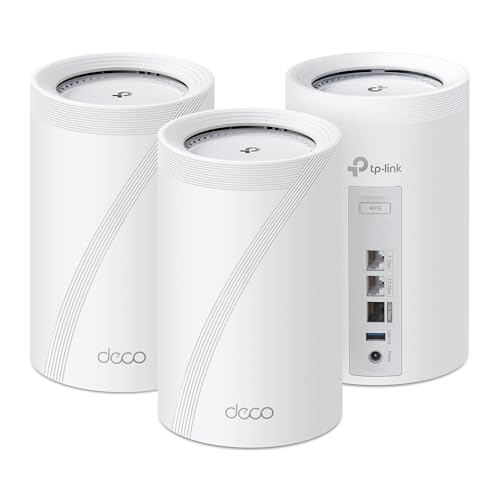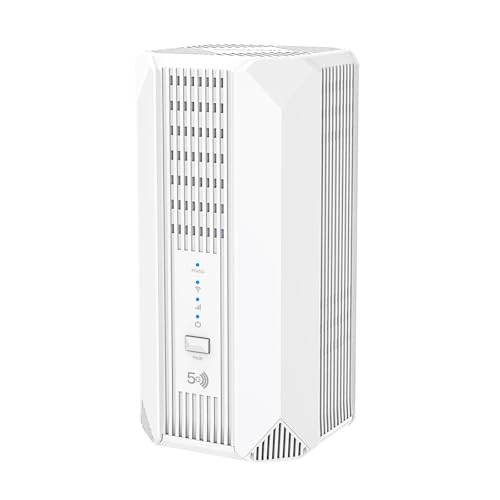10 Best Router With Bandwidth Control: In-depth Reviews
Mike Kim Jan 1, 2026 11:56 AM
Optimizing your home network for maximum efficiency and productivity requires more than just speed – it demands control. Enter the world of routers equipped with bandwidth control features. In this guide, we explore the top contenders for the title of the 'best router with bandwidth control,' empowering you to manage and prioritize your internet traffic with ease. Whether you're a gamer, streamer, or remote worker seeking to optimize your online experience, we've handpicked the routers that offer superior bandwidth management capabilities without compromising on performance.
Top Picks
Source: Amazon
Best VPN Router: Synology RT2600ac – 4x4 dual-band Gigabit Wi-Fi router
Pros
-
High-speed performance
-
MU-MIMO support
-
Advanced traffic control
-
Dual WAN capability
Cons
-
Bulky design
Synology RT2600ac delivers a strong combination of speed, coverage, and advanced networking features. Powered by a 1.7GHz dual-core processor, it supports 4x4 802.11ac Wave 2 radios with MU-MIMO, reaching up to 2.53Gbps. Smart Connect allows seamless switching between optimal speed and coverage, while hardware-accelerated Layer 7 traffic control provides detailed monitoring and prioritization. Dual WAN support offers load balancing and failover for uninterrupted connectivity. VPN options are robust, including WebVPN, Synology SSL VPN, and SSTP VPN, making it ideal for secure remote access.
From a customer perspective, users appreciate the router’s high performance and flexibility for both home and small office use. The setup is relatively straightforward with clear guides, and the extensive feature set appeals to tech-savvy users. The main drawback noted is its larger footprint, which may require careful placement. Overall, it’s a capable router that balances speed, security, and advanced networking functions effectively.
Best Wi-Fi 7: TP-Link Archer BE6500 Dual-Band Wi-Fi 7 Router
Pros
-
Multi-Link Operation
-
Ultra-fast speeds
-
Wide coverage
-
Advanced security
Cons
-
Premium price
TP-Link Archer BE400 brings the latest Wi-Fi 7 technology to the home network, delivering impressive speeds and reliability. With 6 streams on dual bands, it achieves up to 5764 Mbps on 5GHz and 688 Mbps on 2.4GHz, supporting seamless 4K/8K streaming, AR/VR gaming, and heavy multi-device usage. The six high-performance antennas with Beamforming ensure stable connections over up to 2,400 sq. ft., accommodating up to 90 devices. Wired performance is equally strong, featuring a 2.5 Gbps WAN/LAN port, a 2.5 Gbps LAN port, and three 1 Gbps LAN ports. Multi-Link Operation improves throughput and latency by balancing traffic across bands, while TP-Link’s cybersecurity measures enhance protection for all connected devices.
Customers appreciate the Archer BE400 for its future-proof performance and strong coverage, particularly in busy households with multiple high-demand devices. Setup is straightforward, and advanced users benefit from fine-tuned controls like QoS and parental controls. The main consideration is its higher cost, which may be a factor for budget-conscious buyers, but its cutting-edge features make it a strong option for those seeking the latest Wi-Fi technology.
Best Wi-Fi 7 Security: ASUS RT-BE58U WiFi 7 BE3600 AiMesh Extendable Router
Pros
-
Multi-Link Operation
-
High-speed 3600 Mbps
-
AiProtection Pro
-
Smart Home integration
Cons
-
Limited device compatibility
ASUS RT-BE58U delivers advanced Wi-Fi 7 performance with dual-band speeds up to 3600 Mbps, enhanced by 4096-QAM for faster single-band transmission. Multi-Link Operation (MLO) enables simultaneous connections across multiple bands, ensuring stable and efficient data transfer. Versatile WAN options allow always-on internet with AI WAN detection and USB support for 4G/5G mobile tethering. Smart Home Master simplifies IoT device management, supports multiple SSIDs, instant VPN connections, and parental controls. Network security is reinforced with commercial-grade AiProtection Pro powered by Trend Micro, offering one-tap scans and Safe Browsing features.
From a customer perspective, the RT-BE58U is ideal for tech-savvy users seeking a secure, high-speed router that handles demanding home or small business networks. Users value its easy setup for smart devices and robust protection against cyber threats. The main drawback is its limited compatibility with non-PC devices, which may restrict full utilization for households heavily relying on smart home gadgets or consoles. Overall, it balances speed, security, and smart home functionality effectively.
Best Tri-Band Gaming: TP-Link AXE5400 Tri-Band WiFi 6E Router
Pros
-
6 GHz Wi-Fi 6E support
-
Tri-Band connectivity
-
High-speed 5400 Mbps
-
HomeShield security
Cons
-
Large footprint
TP-Link Archer AXE75 is a tri-band Wi-Fi 6E router designed for high-performance gaming, streaming, and multi-device households. The router delivers combined speeds up to 5400 Mbps across 2.4 GHz, 5 GHz, and the new 6 GHz band, reducing latency and improving responsiveness for gaming and video calls. Tri-band and OFDMA technology allow simultaneous connections to multiple devices, while a 1.7 GHz quad-core CPU with 512 MB memory ensures smooth processing for demanding applications. OneMesh compatibility enables seamless whole-home coverage, and VPN server/client support provides flexible remote access. TP-Link HomeShield enhances network and IoT security with basic parental controls, quality of service, and device monitoring.
Customers appreciate the AXE75 for its robust speeds, low-latency performance, and ability to handle numerous devices without compromise. Setup is generally user-friendly, and gamers particularly value the 6 GHz band for smoother online experiences. The main drawback is its larger physical size, which requires ample space for placement. Overall, it provides a powerful combination of speed, connectivity, and security for modern home and gaming networks.
Best Wi-Fi 7 Tri-Band: TP-Link Tri-Band BE9300 WiFi 7 Router (Archer BE550)
Pros
-
Multi-Link Operation
-
Ultra-fast 5760 Mbps
-
EasyMesh coverage
-
HomeShield security
Cons
-
Internal antennas only
TP-Link Archer BE550 delivers next-generation Wi-Fi 7 performance with tri-band speeds reaching 5760 Mbps on the 6 GHz band, 2880 Mbps on 5 GHz, and 574 Mbps on 2.4 GHz. Multi-Link Operation, Multi-RUs, 4K-QAM, and 320 MHz channels optimize speed and reliability for 4K/8K streaming, AR/VR gaming, and high-speed downloads. EasyMesh support allows seamless expansion across compatible routers, extenders, and powerline adapters, minimizing dead zones and signal drops. Equipped with full 2.5G WAN and LAN ports, it provides future-proof connectivity for high-performance devices. Six strategically positioned antennas with Beamforming enhance coverage and stability, while TP-Link HomeShield offers network protection, parental controls, and real-time IoT security.
From a customer perspective, the Archer BE550 excels in speed, coverage, and security for households with multiple high-demand devices. Users highlight smooth streaming and gaming performance along with straightforward network expansion via EasyMesh. The main limitation is its internal antennas, which may slightly reduce peak coverage compared to external designs. Overall, it balances cutting-edge Wi-Fi 7 speeds with reliable security and home networking flexibility.
- 9.4
- BrandTP-Link
- 9.2
- BrandTP-Link
- 9.0
- BrandGL.iNet
- 8.9
- BrandTP-Link
- 8.7
- BrandTP-Link
- 8.4
- BrandNETGEAR
- 8.0
- BrandNETGEAR
Last update on 2026-01-01 / Affiliate links / Images, Product Titles, and Product Highlights from Amazon Product Advertising API
Managing your internet bandwidth with your router involves several techniques and settings that allow you to prioritize certain types of traffic, limit bandwidth usage for specific devices or applications, and optimize overall network performance. Here are some common methods for managing internet bandwidth with your router:
Quality of Service (QoS): Most modern routers support QoS features, which allow you to prioritize certain types of traffic over others. You can typically configure QoS settings to prioritize activities like video streaming, online gaming, or VoIP calls to ensure a smooth and uninterrupted experience, even when other devices are using the network.
Bandwidth Limiting: Some routers allow you to set bandwidth limits for individual devices or applications. This can be useful for preventing certain devices or applications from consuming too much bandwidth and causing slowdowns for other users. For example, you could limit the bandwidth for file-sharing applications or devices that are known to use excessive amounts of data.
Access Control: Many routers offer access control features that allow you to restrict internet access for specific devices or users. This can be useful for limiting access to certain websites or services, setting time-based access schedules, or blocking access entirely for unauthorized devices.
Traffic Monitoring: Some routers come with built-in traffic monitoring tools or support third-party applications that allow you to monitor bandwidth usage in real-time. By keeping an eye on which devices and applications are using the most bandwidth, you can identify potential bottlenecks and take steps to optimize your network accordingly.
Firmware Updates: Keeping your router's firmware up to date is essential for ensuring optimal performance and security. Router manufacturers often release firmware updates that include bug fixes, performance improvements, and new features, so it's a good idea to check for updates regularly and install them as needed.
By leveraging these techniques and settings, you can effectively manage your internet bandwidth with your router to ensure a smooth and reliable online experience for all users and devices on your network.
Should I enable Bandwidth Control?
Whether you should enable bandwidth control on your router depends on your specific needs and usage patterns. Bandwidth control, also known as bandwidth limiting or traffic shaping, can be a useful feature for managing internet usage and optimizing network performance. Here are some factors to consider when deciding whether to enable bandwidth control:
Prioritization: Bandwidth control allows you to prioritize certain types of traffic or devices over others. If you have activities that require low latency and consistent speeds, such as online gaming or VoIP calls, enabling bandwidth control can help ensure a smooth experience by giving priority to these activities.
Fairness: Bandwidth control can help ensure fairness and prevent certain devices or applications from monopolizing the available bandwidth. If you have multiple users or devices sharing the same network and want to prevent one user or device from overwhelming the network with excessive data usage, enabling bandwidth control can help distribute bandwidth more equitably.
Data Usage Limits: Bandwidth control allows you to set data usage limits for individual devices or applications, which can be useful for preventing excessive data usage or staying within the limits of your internet service plan. If you have a limited data cap or want to avoid overage charges, enabling bandwidth control can help you monitor and control data usage more effectively.
Network Optimization: Enabling bandwidth control can help optimize your network by reducing congestion and ensuring that critical tasks or applications receive the necessary bandwidth to operate smoothly. By controlling bandwidth usage, you can minimize latency, reduce packet loss, and improve overall network performance.
Complexity and Configuration: It's important to consider the complexity and configuration required to enable bandwidth control on your router. Depending on your router model and firmware, configuring bandwidth control settings may require some technical expertise and familiarity with your router's interface. If you're comfortable with configuring router settings and understand the potential impact on your network, enabling bandwidth control can be beneficial.
Ultimately, whether you should enable bandwidth control depends on your specific requirements, priorities, and technical proficiency. If you value network optimization, fairness, and control over bandwidth usage, enabling bandwidth control may be worth considering. However, if you prefer simplicity and don't have specific requirements for managing bandwidth, you may choose to leave bandwidth control disabled.
Is there a way to limit bandwidth?
Yes, there are several ways to limit bandwidth on your network, depending on your router's capabilities and the level of control you require. Here are some common methods:
Quality of Service (QoS): Most modern routers support QoS features, which allow you to prioritize certain types of traffic over others. By configuring QoS settings, you can allocate a specific amount of bandwidth to different types of activities, such as video streaming, online gaming, or VoIP calls. This ensures that critical tasks receive the necessary bandwidth while limiting the bandwidth available to less important activities.
Bandwidth Limiting: Some routers allow you to set bandwidth limits for individual devices or applications. This can be done through the router's settings or using third-party firmware like DD-WRT or Tomato. By specifying a maximum bandwidth allocation for certain devices or applications, you can prevent them from consuming excessive bandwidth and causing slowdowns for other users.
Access Control: Many routers offer access control features that allow you to restrict internet access for specific devices or users. By blocking access to certain websites or services, setting time-based access schedules, or limiting the number of devices that can connect to the network simultaneously, you can effectively control bandwidth usage and prevent excessive data consumption.
Traffic Monitoring and Management: Some routers come with built-in traffic monitoring tools or support third-party applications that allow you to monitor bandwidth usage in real-time. By identifying which devices or applications are using the most bandwidth, you can take steps to optimize your network and limit bandwidth usage as needed.
Firmware Updates and Third-Party Solutions: Keeping your router's firmware up to date is essential for ensuring optimal performance and security. In addition to the built-in features provided by your router's manufacturer, you can also explore third-party firmware solutions like OpenWRT, DD-WRT, or Tomato, which offer advanced bandwidth management capabilities and greater flexibility in configuring your network.
By leveraging these methods, you can effectively limit bandwidth on your network to ensure a smooth and reliable online experience for all users and devices.
Read more:
- 10 Best Cheap Wifi Mesh in 2026 Review & Buyer's Guide
- 10 Best Optical Fiber Router: In-depth Reviews
- 10 Best Openwrt in 2026 - Features and FAQs
- 10 The Best Router For Video Conferencing Buyer's Guide for 2026 | SHR
- The Best Wifi Router: Reviews and Rankings for you
In conclusion, finding the best router with bandwidth control is essential for households or offices that require efficient network management and consistent performance across multiple devices. Routers with robust bandwidth control features allow you to prioritize critical tasks, limit unnecessary data usage, and prevent network congestion, ensuring a smoother online experience for everyone. By focusing on factors such as speed, range, ease of configuration, and QoS capabilities, users can choose a router that not only meets their current needs but also adapts to future demands. Investing in the right device ultimately provides a more reliable, organized, and high-performing network, making it a valuable addition to any connected environment.






























